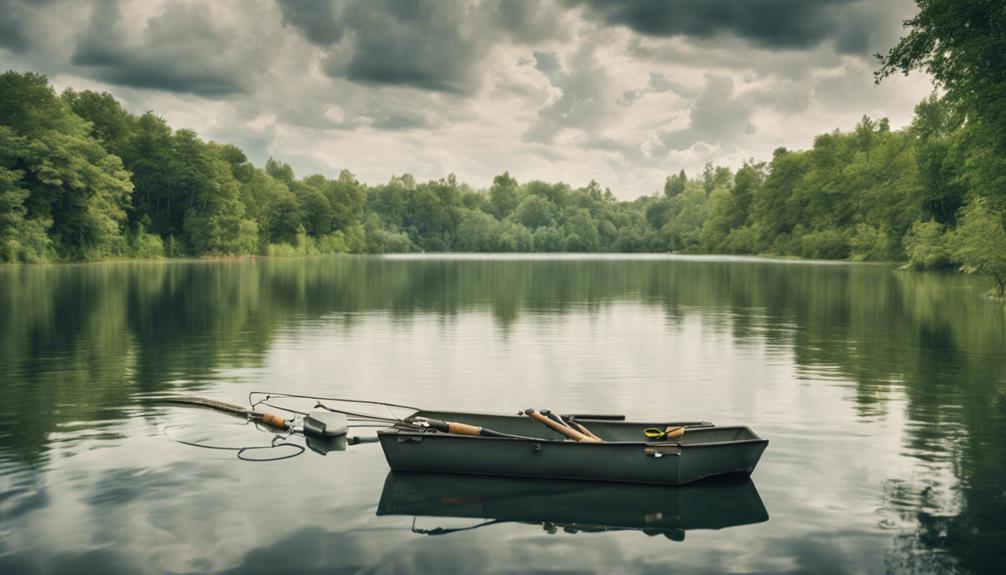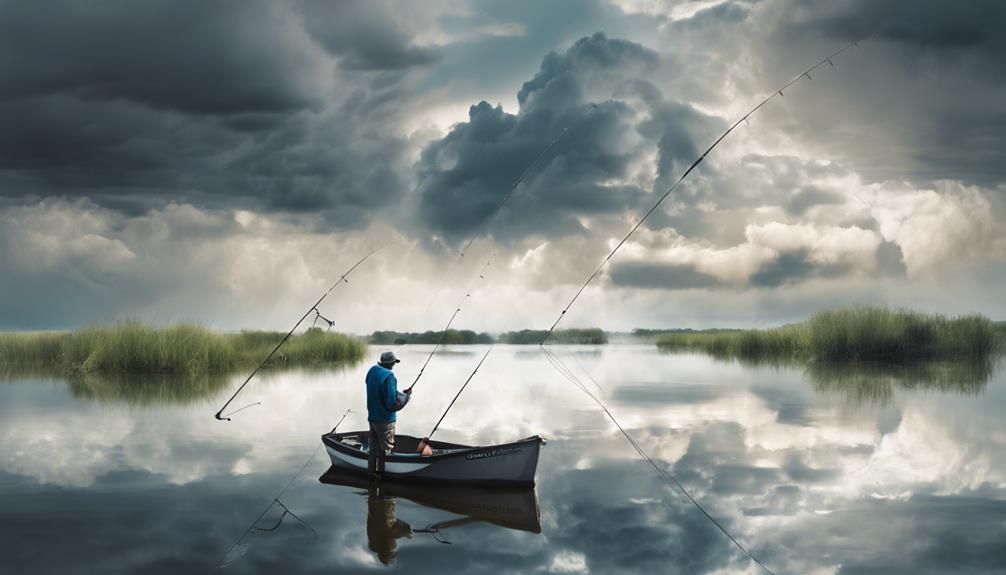Wind direction, temperature shifts, and barometric pressure impact your fishing spots significantly. Fish behavior and habitat preferences are influenced by these weather factors. Wind patterns can affect where fish congregate, while changes in temperature can alter their feeding habits. Barometric pressure plays a role in determining fish movement, with high pressure pushing them deeper and low pressure bringing them closer to the surface. Understanding these weather dynamics is crucial for successful fishing outings. Knowing how weather affects fish behavior and habitat choices can help you optimize your fishing strategy. Keep in mind these variables for a more productive time on the water.
Weather Patterns & Fishing Success
When analyzing the relationship between weather patterns and fishing success, it's crucial to consider the impact of atmospheric conditions on fish behavior. Water clarity plays a significant role in how fish respond to various weather patterns. During periods of stable weather, such as on clear, sunny days, water clarity tends to improve. This increased clarity can make it easier for fish to spot bait, leading to heightened fishing success. Conversely, when weather patterns are turbulent, with heavy rainfall or strong winds, water clarity decreases, making it harder for fish to see bait and reducing fishing success.
Moon phases also have a notable impact on fishing success. Fish behavior is influenced by the moon's phases, with many species being more active during certain lunar stages. For example, during a full moon, some fish species may feed more actively at night, affecting their behavior during the day. Anglers who understand these patterns can adjust their fishing techniques accordingly, potentially increasing their success rates.
Wind Direction & Its Impact
Considering the influence of wind direction on fishing spots, anglers must carefully assess its impact on fish behavior and overall fishing success. Wind direction plays a crucial role in determining the movement of water, affecting tides and currents, which in turn influence the behavior of fish. When the wind blows parallel to the shoreline, it can create upwelling or downwelling, bringing nutrients to the surface or pushing them deeper, respectively. This phenomenon attracts baitfish, leading predators to follow and creating prime fishing conditions.
Moreover, wind direction can influence the distribution of temperature layers in the water. For example, a strong wind blowing over a body of water can cause surface water to move, leading to a mixing of the water column. This mixing can impact the distribution of oxygen and temperature, affecting where fish are likely to be found.
In addition to tides and currents, anglers should also consider moon phases and solunar activity when taking wind direction into account. Certain phases of the moon and solunar periods can enhance fish feeding behavior, and when coupled with favorable wind directions, can significantly increase fishing success.
Therefore, when planning your fishing trip, pay close attention to wind direction as it can provide valuable insights into where fish might be located and how they're behaving based on the conditions created by the wind.
Temperature Variations & Fish Behavior
Examining temperature variations is essential for understanding how fish behavior is impacted in different fishing spots. Temperature plays a crucial role in influencing water clarity, fish feeding patterns, oxygen levels, and fish movement.
- Water Clarity: Temperature changes can affect the transparency of the water. Warmer temperatures may lead to an increase in algae growth, potentially reducing water clarity and impacting fish visibility.
- Fish Feeding: Temperature fluctuations can directly impact fish metabolism and feeding habits. Warmer waters may increase fish activity levels, leading to more feeding behavior.
- Oxygen Levels: Temperature variations influence the amount of oxygen dissolved in the water. Warmer water holds less oxygen than cooler water, affecting fish respiration and overall oxygen availability for aquatic life.
- Fish Movement: Fish are sensitive to temperature changes and may migrate to different depths or areas of a water body in search of their preferred temperature range. Understanding these movements is crucial for successful fishing.
Barometric Pressure & Fishing Results
Barometric pressure directly influences fishing results by affecting fish behavior and feeding activity. Fish are sensitive to changes in barometric pressure, which refers to the weight of the air pressing down on Earth. When the pressure is high, fish tend to move towards deeper waters as they feel heavier pressure on their bodies. Conversely, when the pressure is low, fish may move to shallower areas as they feel less pressure, making it easier for them to swim.
Understanding how barometric pressure impacts fish behavior can help you choose the best fishing spots. Before a high-pressure system moves in, fish may be more active and feeding, making it an ideal time to fish. As the pressure changes, fish might become less active, leading to decreased feeding activity. Therefore, monitoring barometric pressure changes can give you insights into when fish are more likely to be actively feeding and when they might be less inclined to bite.
Cloud Cover & Fish Activity
Cloud cover can significantly impact fish activity levels by altering light penetration and influencing their feeding behavior. When the sky is overcast, sunlight intensity decreases, affecting the visibility of prey for fish. This reduction in light can make it harder for fish to spot their food, leading to decreased feeding activity.
Additionally, cloud cover can impact fish behavior in relation to moon phases. Here are some key points to consider:
- Light Penetration: Thick cloud cover diminishes the amount of sunlight that reaches the water's surface, reducing the visibility for fish to hunt effectively.
- Feeding Patterns: Fish may become less active and feed less frequently under heavy cloud cover due to the reduced light levels affecting their ability to locate prey.
- Moon Phases: Cloud cover can obscure the moon, which plays a crucial role in fish behavior. During full moons, fish tend to be more active, but if clouds obstruct the moonlight, their behavior might change.
- Predator-Prey Dynamics: Cloud cover can disrupt the balance between predators and prey. Predators may struggle to hunt effectively, while prey species might take advantage of the reduced visibility to evade capture.
Understanding how cloud cover influences fish activity is essential for adapting your fishing techniques to optimize success on the water. By considering these factors, you can increase your chances of a successful fishing trip.
Precipitation Effects on Fishing
When fishing, precipitation can have a significant impact on fish behavior and ultimately affect your success on the water. Rainfall patterns play a crucial role in determining how fish behave. Before a storm, fish tend to become more active and feed more aggressively, anticipating a decrease in food availability during the rough weather. As the rain begins, fish near the surface may become more active, while those preferring deeper waters might move closer to the shore seeking shelter. Understanding these patterns can help you adjust your fishing techniques accordingly.
In stormy weather, fishing strategies need to be adapted to the conditions. Fish are more likely to seek shelter in calmer waters or near structures like rocks or vegetation during heavy rain. Using bait that mimics injured prey or seeking out areas with overhangs can be effective during these times. Additionally, adjusting your presentation to be more subtle in murky waters caused by rainfall can attract fish that are relying more on their senses of vibration and smell than sight.
Seasonal Changes & Fishing Spots

Seasonal changes play a significant role in determining optimal fishing spots as fish behavior shifts with the varying environmental conditions throughout the year. Understanding these changes is crucial for successful angling. Here's a breakdown of how seasonal variations impact fishing spots:
- Water Currents: In different seasons, water currents fluctuate due to factors like temperature and wind patterns. Fish tend to follow these currents, so identifying and fishing in areas where water movement is prominent can lead to more bites.
- Fishing Locations: As seasons change, fish migrate to different depths and areas. For example, during spring, many fish move to shallower waters for spawning, while in winter, they may seek deeper, warmer locations. Adapting your fishing spots according to these movements is key.
- Tidal Movements: Tides play a crucial role in fish behavior. Understanding how tides affect the movement of baitfish and prey can help you predict where predatory fish will be located at different times of the day.
- Fishing Strategies: With seasonal changes come variations in fish feeding habits. Adjusting your fishing strategies to match these behaviors is essential. For instance, using different baits or fishing techniques based on the time of year can significantly increase your chances of a successful catch.
Weather Apps for Anglers
Utilize advanced weather apps tailored for anglers to enhance your fishing experience and increase your chances of success through precise meteorological insights. When it comes to fishing, having access to accurate weather information is crucial for planning your trip effectively. Weather apps designed specifically for anglers offer a range of features that can help you make informed decisions.
One key feature in these apps is tides tracking. Tides play a significant role in fish behavior, as they influence the movement and feeding patterns of various species. By using a weather app that includes tides tracking, you can determine the best times to fish based on the tide conditions at your location.
Another essential aspect to consider is moon phases. The moon has a direct impact on fish activity, with certain phases being more favorable for fishing than others. Weather apps for anglers often provide detailed information about the moon phases, allowing you to plan your fishing trips around the optimal lunar conditions.
Frequently Asked Questions
How Do Lunar Phases Affect Fishing Success?
When it comes to fishing success, understanding how lunar phases affect tidal patterns is crucial. The gravitational pull of the moon influences tides, impacting fish activity.
During a full moon, increased moonlight can stimulate fish to feed more actively. Conversely, during a new moon, lower light conditions may lead to decreased fish activity.
Does Water Clarity Play a Role in Fish Biting?
Water clarity plays a crucial role in fish biting. Temperature fluctuations and wind patterns impact water clarity, affecting how well fish can see your bait.
Clear water may require more natural-looking lures and stealthier approaches. Murky water might call for brighter or louder lures to attract fish.
Understanding how water clarity changes with weather conditions can help you adapt your fishing techniques for better success.
What Impact Does Air Humidity Have on Fish Behavior?
When air humidity shifts, it can impact fish behavior. Temperature changes tied to humidity can affect fish feeding patterns.
Barometric pressure fluctuations, often linked to humidity levels, can also influence fish activity. Understanding these correlations can help you predict when fish might be more or less active based on the humidity in the air.
Can Fishing During Sunrise or Sunset Be More Productive?
Fishing during sunrise or sunset can be more productive due to tidal movements affecting fish behavior. These times coincide with changes in temperature, influencing fish activity levels.
Bait selection becomes crucial during these periods as fish are more likely to be actively feeding. By understanding how these factors interact, you can increase your chances of a successful fishing trip.
Paying attention to these details can greatly enhance your fishing experience.
Is There a Correlation Between Thunderstorms and Fish Feeding?
When thunderstorms roll in, barometric pressure drops, impacting fish feeding patterns. Lightning strikes can change fish activity, sometimes making them more active.
This correlation between thunderstorms and fish behavior is important to consider when planning your fishing trips. Being aware of how weather influences fish can help you anticipate when they might be more active or inactive, ultimately increasing your chances of a successful catch.
Conclusion
In conclusion, understanding how weather patterns influence fish behavior is crucial for success in fishing. Factors such as wind direction, temperature variations, barometric pressure, cloud cover, precipitation, and seasonal changes all play a role in determining the best fishing spots.
By utilizing weather apps and staying informed about current conditions, anglers can adapt their strategies and increase their chances of a successful fishing trip. Weather isn't just a background element, but a key factor in determining fishing success.



